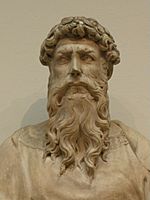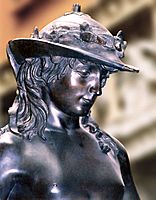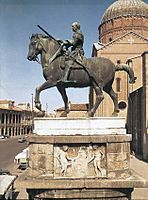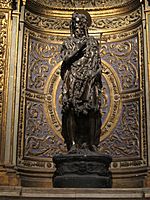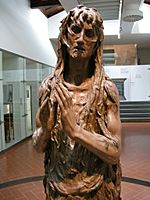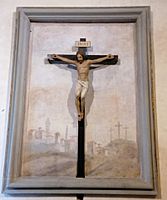Donatello facts for kids
Quick facts for kids
Donatello
|
|
|---|---|
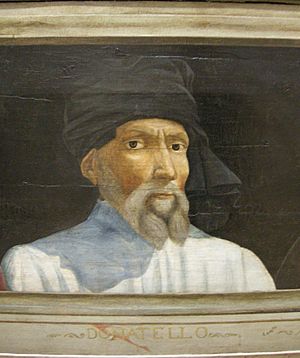
Donatello, in a 15th-century portrait by an unknown artist
|
|
| Born |
Donato di Niccolò di Betto Bardi
c. 1386 Republic of Florence
|
| Died | 13 December 1466 (aged 79–80) Republic of Florence
|
| Nationality | Florentine |
| Education | Lorenzo Ghiberti |
| Known for | Sculpture |
|
Notable work
|
Saint George, David, Equestrian Monument of Gattamelata |
| Movement | Early Renaissance |
Donato di Niccolò di Betto Bardi (around 1386 – 13 December 1466), known as Donatello, was a famous Italian sculptor. He lived during the Renaissance period.
Donatello studied old classical sculpture from ancient Greece and Rome. He used these ideas to create a new, complete Renaissance style in his own sculptures. He traveled to many Italian cities like Rome, Padua, and Siena. In these places, he worked on art projects and taught other artists.
Contents
Life and travels
Donatello was born in Florence, probably in 1386. His father, Niccolò di Betto Bardi, was a member of a guild (a group of skilled workers) in Florence. Donatello grew up in the home of the Martelli family.
He likely learned art in a workshop where people made things from gold. Later, he worked for a short time with another artist named Lorenzo Ghiberti.
In 1401, Donatello met Filippo Brunelleschi in Pistoia. They probably went to Rome together around 1403. They stayed there for about a year to study old buildings and ruins. Brunelleschi taught Donatello about making things from gold and about sculpture. Both Brunelleschi's buildings and Donatello's sculptures are seen as amazing examples of art from that time.
Donatello worked in Florence from about 1406 to 1430. After that, he spent some time in Rome. He came back to Florence around 1433 or 1434. Until 1443, he also worked in Prato and Venice.
In 1443, Donatello was asked to work in Padua. He stayed there until 1453, then returned to Florence. Donatello died in Florence on December 13, 1466. We don't know exactly why he died.
Artistic style and famous works
Donatello's art was inspired by ancient sculptures. He was one of the first sculptors of his time to show the human body in a realistic way. This idea had mostly been forgotten since the times of Greek and Roman art.
His life-size statue of David is his most famous work. This statue of David was the first free-standing nude (naked) statue made since ancient times. Many of Donatello's sculptures were made for large churches. Between 1415 and 1426, he created five statues for the Florence Cathedral, also known as the Duomo.
Donatello was a realist. This means he was an artist who showed his subjects as real people. He focused on making his sculptures look natural and show human feelings.
Interesting facts about Donatello
- He worked with many materials, including stone, bronze, wood, clay, stucco (a type of plaster), and wax.
- Donatello usually had several helpers, often around four.
- His most famous works are statues, but he also made small and large bas-reliefs. These are sculptures where the figures stick out only a little from a flat background.
- He created statues for churches, monasteries, and private homes. He also made art for important people like Cosimo de' Medici and city leaders.
- Donatello has appeared in popular culture, including movies, TV shows, and video games.
- A character in the Teenage Mutant Ninja Turtles cartoon and comic series is named after him.
Gallery
-
A close-up of Donatello's famous David statue.
-
Madonna and Child, made of painted terracotta around 1440, now in the Louvre museum.
-
Equestrian Monument of Gattamelata (1445–1450), a large statue of a man on horseback in Padua.
-
Statue of St. John the Baptist in the Duomo di Siena (Siena Cathedral), around 1455.
2020 discovery
In 2020, an art historian named Gianluca Amato made an exciting discovery. He was studying wooden crucifixes (statues of Jesus on the cross) for his university research. He found that a crucifix in the church of Sant'Angelo a Legnaia was actually made by Donatello!
This discovery has been carefully checked by other historians. Silvia Bensì also worked to restore the crucifix, helping to preserve this important piece of art.
Related pages
See also
 In Spanish: Donatello para niños
In Spanish: Donatello para niños


